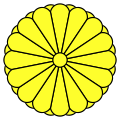- Emperor Chūai
-
Chūai Emperor of Japan 
Reign legendary Born legendary Died legendary Buried Ega no Naganu no nishi no misasagi (Osaka) Predecessor Seimu Successor Ōjin Emperor Chūai (仲哀天皇 Chūai-tennō); also known as Tarashinakatsuhiko no Sumeramikoto; was the 14th emperor of Japan,[1] according to the traditional order of succession.[2]
No firm dates can be assigned to this emperor's life or reign, but he is conventionally considered to have reigned from 192–200.[3]
Contents
Legendary narrative
Chūai is regarded by historians as a "legendary emperor" and there is a paucity of information about him. There is insufficient material available for further verification and study.[4] If Chūai did exist, there is no evidence to suggest that the title tennō was used during the time period to which his reign has been assigned. It is much more likely that he was a chieftain, or local clan leader, and the polity he ruled would have only encompassed a small portion of modern day Japan. The name Chūai Tennō was assigned to him posthumously by later generations.[5]
According to the Kojiki and Nihonshoki, he was the father of Emperor Ōjin. Ōjin is generally believed to have existed, based on archaeological evidence;[4] but details of his life are scant.
Chūai's father was Yamato Takeru, a son of the Yamato monarch Emperor Keikō, but Yamato Takeru's story is problematic. Chūai's mother was Futaji no Iri Hime no Mikoto, a daughter of Emperor Kaika and an aunt of Chūai's father. Chūai's wife was Jingū.
According to these same legends, his wife was suddenly possessed by some unknown gods. The gods promised Emperor Chūai rich lands overseas. Chūai then looked to the sea, but he could see nothing and denounced his belief in the promises of the gods. The gods were enraged by this and declared that he would die and never receive the promised land. Instead they would go to his conceived but unborn son. The legend then states that Chūai died soon after and his widow, Jingū, conquered the promised land, which is conjectured to be part of modern day Korea. According to one version of the legend, Chūai's son was born three years after the death of Chūai, which lends further support to the notion that the stories surrounding him are based on myth rather than actual events. This legend also has many other flaws (it claims that Jingū was flown into the middle of the promised land and then conquered into Japan) which have largely discredited the story among historians.[6]
The actual site of Chūai's grave is not known.[1] This emperor is traditionally venerated at a memorial Shinto shrine (misasagi) at Nara.
The Imperial Household Agency designates this location as Chūai's mausoleum. It is formally named Ega no Naganu no nishi no misasagi.[7]
Consorts and Children
Empress Okinagatarashihime (気長足姫) Empress Jingū, daughter of Okinaga no sukune no Miko (息長宿禰王)
- Prince Homutawake (誉田別命) Emperor Ōjin
Ōnakatsuhime (大中姫命), daughter of Hikohitoōe no Mikoto (彦人大兄)
- Prince Kagosaka (麛坂皇子)
- Prince Oshikuma (忍熊皇子)
Otohime (弟媛), daughter of Ōsakanushi(大酒主)
- Prince Homuyawake (誉屋別皇子)
See also
- Emperor of Japan
- List of Emperors of Japan
- Imperial cult
Notes
- ^ a b Imperial Household Agency (Kunaichō): 仲哀天皇 (14)
- ^ Varley, Paul. (1980). Jinnō Shōtōki, pp. 100-101; Titsingh, Isaac. (1834). Annales des empereurs du japon, p. 15. at Google Books
- ^ Ponsonby-Fane, Richard. (1959). The Imperial House of Japan, p. 34.
- ^ a b Kelly, Charles F. "Kofun Culture," Japanese Archaeology. April 27, 2009.
- ^ Brinkley, Frank. (1915). A History of the Japanese People from the Earliest Times to the end of the Meiji Era, p. 21 at Google Books; excerpt, "Posthumous names for the earthly Mikados were invented in the reign of Emperor Kammu (782-805), i.e., after the date of the compilation of the Records and the Chronicles.
- ^ Aston, William. (1998). Nihongi, Vol. 1, pp. 217-223.
- ^ Ponsonby-Fane, p. 419.
References
- Aston, William George. (1896). Nihongi: Chronicles of Japan from the Earliest Times to A.D. 697. London: Kegan Paul, Trench, Trubner. OCLC 448337491
- Brown, Delmer M. and Ichirō Ishida, eds. (1979). Gukanshō: The Future and the Past. Berkeley: University of California Press. 10-ISBN 0-520-03460-0; 13-ISBN 978-0-520-03460-0; OCLC 251325323
- Chamberlain, Basil Hall. (1920). The Kojiki. Read before the Asiatic Society of Japan on April 12, May 10, and June 21, 1882; reprinted, May, 1919. OCLC 1882339
- Ponsonby-Fane, Richard Arthur Brabazon. (1959). The Imperial House of Japan. Kyoto: Ponsonby Memorial Society. OCLC 194887
- Titsingh, Isaac. (1834). Nihon Odai Ichiran; ou, Annales des empereurs du Japon. Paris: Royal Asiatic Society, Oriental Translation Fund of Great Britain and Ireland. OCLC 5850691
- Varley, H. Paul. (1980). Jinnō Shōtōki: A Chronicle of Gods and Sovereigns. New York: Columbia University Press. 10-ISBN 0-231-04940-4; 13-ISBN 978-0-231-04940-5; OCLC 59145842
Regnal titles Preceded by
Emperor SeimuLegendary Emperor of Japan
192–200
(traditional dates)Succeeded by
Empress JingūMonarchs of Japan (List) - Family Tree
- Imperial House
Legendary period 
Kofun period Asuka period (552–710) Nara period (710–794) Heian period (794–1185) Kamakura period (1185–1333) Northern Court (1333–1392) Muromachi period (1333–1573) Momoyama period (1573–1603) Edo period (1603–1868) Prewar period (1868–1945) Postwar period (1945–present) ♀ - EmpressesCategories:- Legendary Emperors of Japan
- People of Yayoi period Japan
- 2nd-century monarchs in Asia
Wikimedia Foundation. 2010.

